

Matt Campbell
2025 Porsche 911 Carrera T review
5 Days Ago
We drive the last Lotus without electrification around Mount Panorama to see if it's a worthy contender to the Porsche 718 Cayman.



Publisher

Publisher


Publisher

Publisher
Where expert car reviews meet expert car buying – CarExpert gives you trusted advice, personalised service and real savings on your next new car.
Full disclosure: this author has a Lotus Emira on order.
The Lotus Emira is a very special car. Not only is it the last-ever Lotus to not carry a form of electrification, it’s also the first all-new car Lotus has built in a very long time.
How long, you ask? The last ‘new’ Lotus was the Evora from 2008, before that it was the Elise/Exige platform that was introduced in 1995. So, when news of the Emira broke earlier this year and the pictures showed one of the best-looking modern sports cars on the market, it was hard not to notice.
Although the production version of the Lotus Emira is not ready yet, we recently went to Bathurst to drive a prototype 3.5-litre V6 manual around the mountain to give you our thoughts.

Before that though, let’s take a look at some facts about the car.
The Emira is built on the Lotus Sports Car Architecture we first heard about back in early 2021, and uses a lightweight bonded aluminium structure, wrapped in a body the company says is inspired by the all-electric Evija.
It has the option of the tried-and-tested Toyota 3.5-litre supercharged V6 offered with a manual transmission (an auto will join eventually), or a 2.0-litre turbocharged unit sourced from Mercedes-AMG (think slightly detuned A45 S) with a seven-speed dual-clutch transmission.
The Emira measures 4412mm long, 1895mm wide and 1225mm tall with a 2575mm wheelbase, which makes it roughly 100mm shorter than a Porsche 911, but 43mm wider with a 35mm longer wheelbase. It also makes it a massive 328mm longer than the Exige.
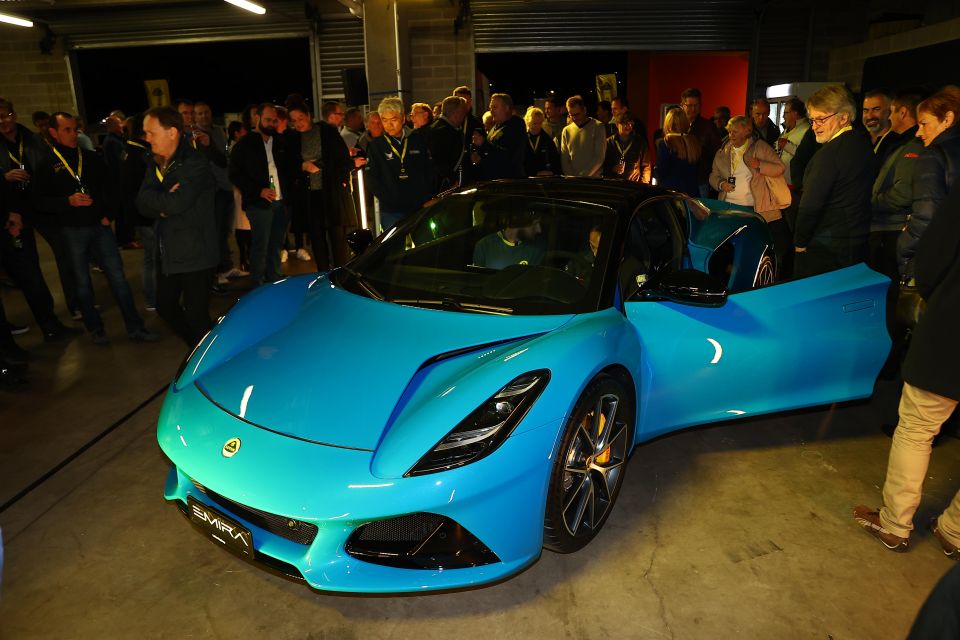
In other words, it’s the first Lotus sports car that sits and looks like a genuine supercar in terms of its proportions and design.
Although figures are yet to be confirmed, Lotus is targeting a kerb weight of 1405kg in the car’s lightest form, around 30kg less than a Porsche 718 Cayman GTS with a dual-clutch transmission, however it’s likely to be around 1430kg for the car we drove here (V6).
Unlike the Elise and Exige, the Emira has power steering, but even then it forgoes a modern electric power steering setup and uses a hydraulic steering system instead, which the Chinese-owned British company says is designed to deliver better feedback to the driver.
There are two suspension tunes on offer: Tour, designed for everyday road use; and Sports, which is fairly self-explanatory and forms part of the Lotus Drivers Pack.

The first Emira variants to touch down will be the V6 First Edition later this year, followed by the AMG-powered four-cylinder versions in the second quarter of 2023.
Pricing will kick off at $155,990 before on-road costs for the Emira four-cylinder DCT, jumping to $169,990 before on-roads for the base V6 manual, and $173,990 before on-roads for the V6 automatic.
The four-cylinder First Edition is priced from $177,990 before on-roads, and the Emira V6 First Edition is listed at $184,990 before on-roads.
2023 Lotus Emira pricing:
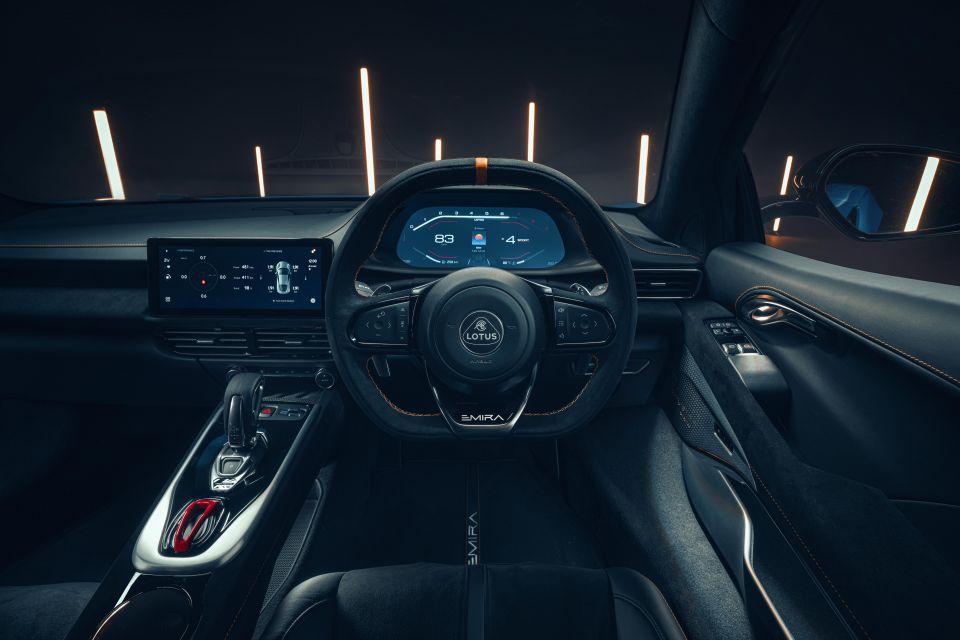
We didn’t get to spend enough time inside the pre-production Lotus Emira to give you a full rundown of what the interior is like, but as a current Series 3 Lotus Elise owner, it didn’t take long to realise it’s worlds apart from Lotus has ever been.
The Emira’s interior may not be the latest in technology and sophistication, but it’s certainly a far more modern package than any Lotus before it. And, the heated and adjustable (driver only) seats are also comfortable enough to be used as a daily.
Perhaps the best news, at least for those that have driven a Lotus sports car before, is that entry and exit from the vehicle no longer requires one to be trained from a young age by an old Russian Gymnastics instructor called Olga.

From a technology perspective, there is a 10.25-inch touchscreen that looks relatively stock on to the centre dashboard and comes equipped with wired Apple CarPlay and Android Auto, while the driver gets to enjoy a beautiful 12.3-inch digital instrument display.
We played with the infotainment system briefly and found it easy and fast enough to use with decent integration and clarity.
Frankly, even a Walkman from 80s would’ve been an upgrade over previous systems, but Lotus has decided to jump about four generations of infotainment at once, bringing to market what should be considered a pretty decent technology suite in 2022.
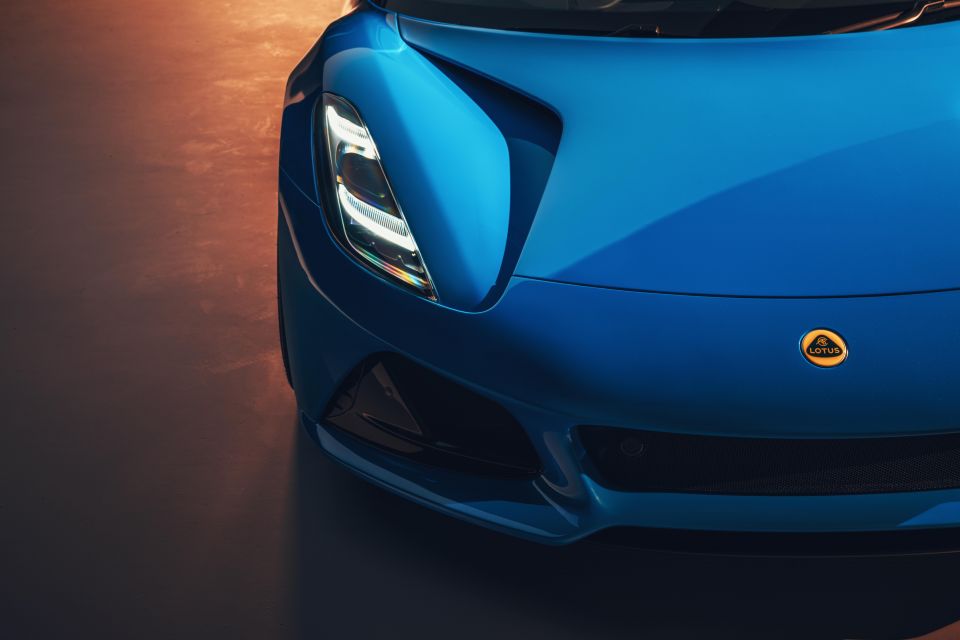
The car we drove had the 3.5-litre supercharged Toyota V6, which in this application develops 298kW of power and 420Nm with the six-speed manual. If you want to forgo some fun, you can bump that up to 430Nm with the upcoming six-speed automatic option with paddle shifters.
If you go for the 2.0-litre turbocharged AMG unit, which is coupled to an eight-speed dual-clutch transmission, you likely get a lighter car that is also quicker around a track. For now, the German heart will put out 268kW of power and 430Nm of torque.
Annoyingly, in the Mercedes-AMG A45 S, the same base engine puts out 310kW and 500Nm. No doubt Lotus is looking to allow some headroom for a future special edition likely to be called the Emira S or Emira R.
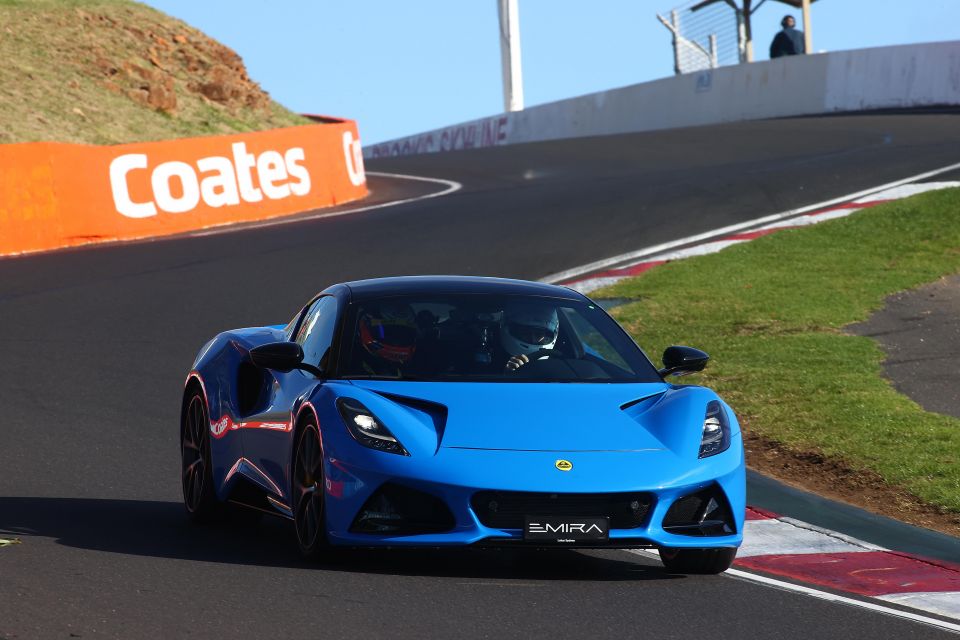
The Emira is a replacement for both the Elise and Exige, so it has relatively large shoes to fill when it comes to track performance. While the two older Lotus models are based on somewhat ancient 90s platforms, even by today’s standards they’re an excellent entry-level track car and/or tarmac rally entry.
The Emira’s challenge was to offer similar performance and usability to a Porsche Cayman. That means it has to be fast, yet usable as a daily.
Although we spent the entirety of our time behind the wheel of this left-hand drive prototype going hell-for-leather around Mount Panorama, it’s pretty easy to say this Lotus is as close as ever to being a proper Porsche rival.
In fact, Lotus’ entire business model and proposition going forward is to be more like Porsche, while keeping its British flavour. That means creating a series of halo sports cars (e.g. Emira) while also making a series of lifestyle family cars (e.g. Electra SUV) where the real volume and profit is.
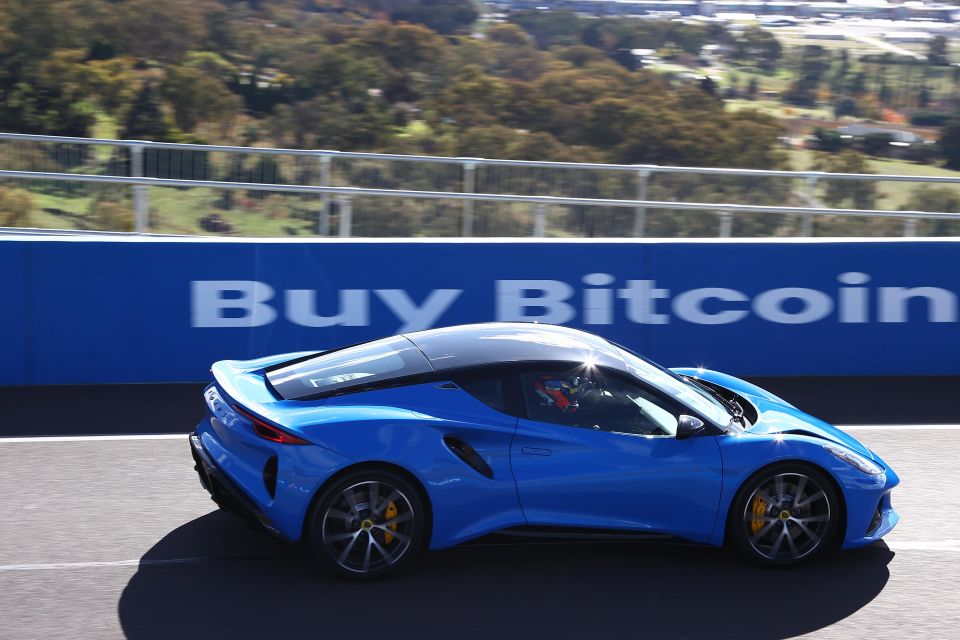
In order to that though, the Emira needs to have far more universal appeal (like a Porsche Cayman) than just being a superlight but glued-together kit car, with all due respect to previous Lotus models.
The good news is the Emira is indeed a proper, outright excellent sports car that would make a perfect daily for any enthusiast. The bad news is that it weighs about 300kg more than the Exige and over 400kg more than the Elise.
That weight disadvantage is the price you pay for having modern safety systems, high strength-steel construction and engineering required to make this an all-round daily driveable vehicle. It also means a 0-100km/h time of 4.3 seconds (4.2s for the auto), which is far from the 3.4-second claim of the manic Final Edition Exige.
Ignoring the uncomfortable left-hand drive manual action in this prototype, the first thing you notice in the Emira is the amount of room between the driver and passenger. Unlike the Exige and Elise, changing gears in the Emira doesn’t also require your passenger’s consent.

The other immediate difference is the power steering. One of the greatest features (and greatest dislikes) of previous Lotus models was the lack of power steering. In the Emira, the hydraulic power steering setup manages to keep feel and driver engagement alive without making every steering input feel like a workout.
While we love the rawness of an unassisted steering system, the Emira’s class and sophistication just wouldn’t suit.
After five laps around Bathurst it’s hard to give you a full report card on how the Lotus Emira performed, but our initial impressions are very positive. The Emira fills you with confidence around corners while never feeling overly harsh or unfriendly.
Our test car came with the harder chassis option riding on super sticky Michelin Pilot Sport Cup 2s, but even then, the mechanical grip was evident from the get go.
From a driving perspective, the front end is extremely precise and minor movements of the steering wheel are reflected in the Emira’s direction on road. It also provides excellent feedback so you know exactly what the front end is doing at all times – this is an integral part of Lotus’ DNA and we’re glad it’s been passed down to the Emira.
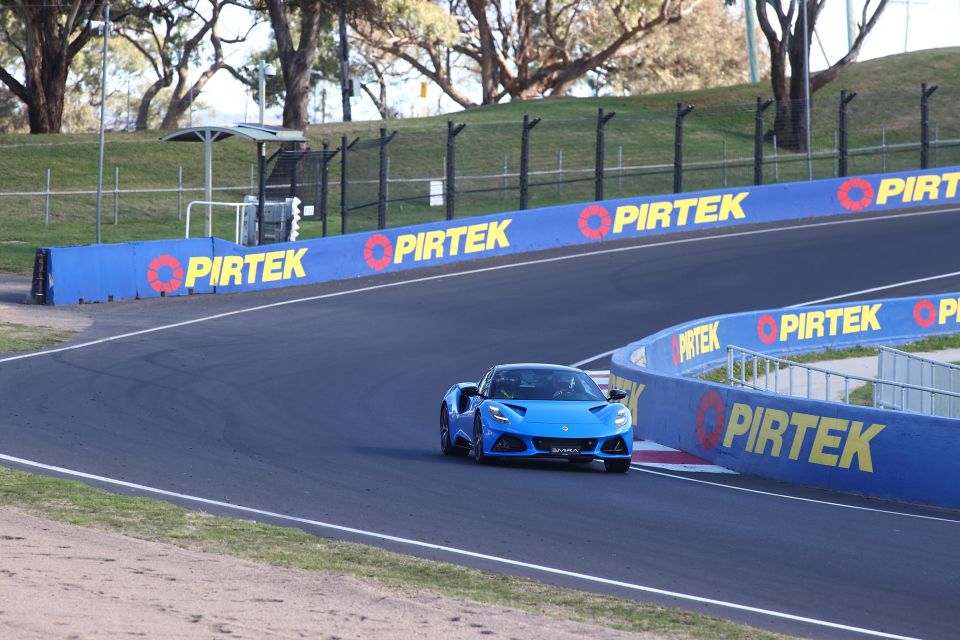
The powerband is not as aggressive in its delivery as the lighter Exige, but the 3.5-litre supercharged Toyota engine has excellent mid-range pull, though we’d like it to rev out a bit further than just 6500rpm.
On that same token, the gearbox in our test car felt a little finicky and notchy, with gears being harder to engage than we would have liked, although we could just as easily blame that on having to change gears with the opposite hand.
The Emira feels quick without feeling super fast, much like the 718 Cayman GTS (0-100 in 4.5s). Although the available AMG-sourced 2.0-litre engine has less power, the extra torque, quick-shifting dual-clutch transmission and lighter weight should make it feel more engaging mid-gear, but we shall see.
One thing we will say in favour of the V6 is the noise. Although it’s nowhere near as loud as an Exige at full scream, the Emira is still a far more visceral driving experience than most would realise, and given the outputs that exact engine in the Exige was making at the end of its life (Exige Cup 430 makes 321kW and 440Nm), there is no reason a basic tune and hardware upgrade couldn’t result in similar outputs for the Emira without having to wait for a special model later.
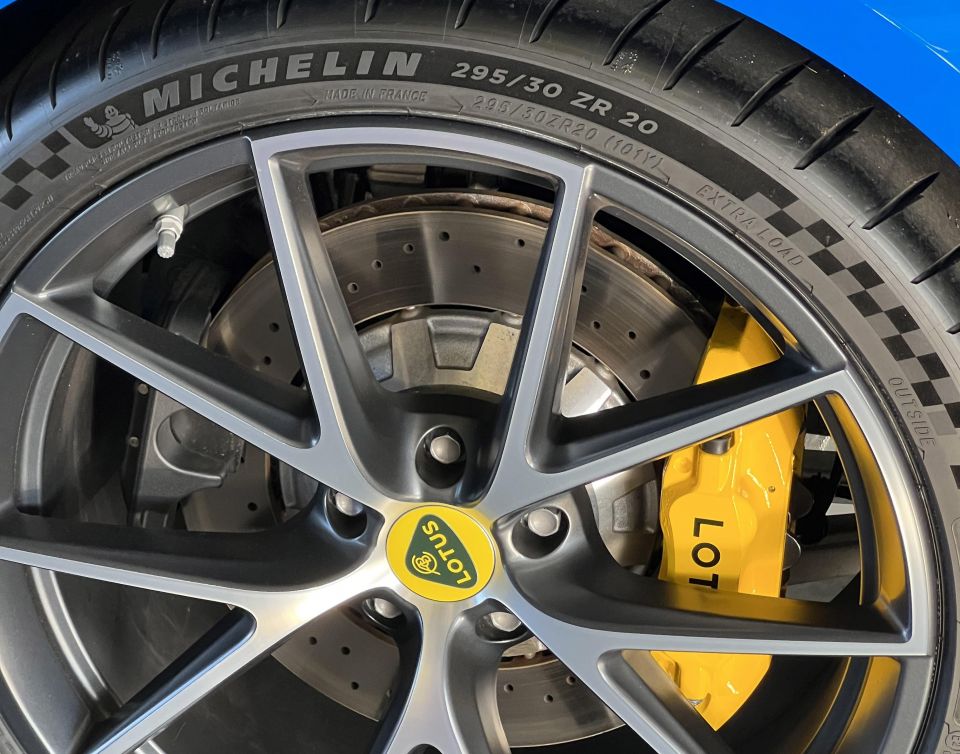
Lotus Australia is also only offering a three-year, unlimited-kilometre warranty, which we feel can be better in this day and age – engine suppliers Mercedes-AMG and Toyota both offer a five-year, unlimited-kilometre warranties.
Full details of the car’s servicing are yet to be finalised, but expect to pay between $400-800 per visit depending on the interval.

Having already ordered a Lotus Emira, there’s probably no higher praise an author can bestow upon a car.
The real question is; does one go for the supercharged V6 manual or the AMG-sourced turbo four with DCT?
My original order was for the four-cylinder, however after driving the V6 and feeling the need to keep a manual Lotus in my life, that preference is now starting to swing the other way.

Where expert car reviews meet expert car buying – CarExpert gives you trusted advice, personalised service and real savings on your next new car.
Click the images for the full gallery
MORE: Everything Lotus Emira
Where expert car reviews meet expert car buying – CarExpert gives you trusted advice, personalised service and real savings on your next new car.
Alborz is the founder of CarAdvice (sold to Nine and now Drive) and co-founder of CarExpert. He is an honourary adjunct professor & entrepreneur in residence at the University of QLD. He loves naturally-aspirated V8s, V10s and V12s and is in denial about the impending death of the internal combustion engine. The best way to reach him is via Instagram.


Matt Campbell
5 Days Ago


James Wong
4 Days Ago


Max Davies
3 Days Ago


Josh Nevett
2 Days Ago


Josh Nevett
1 Day Ago


William Stopford
10 Hours Ago